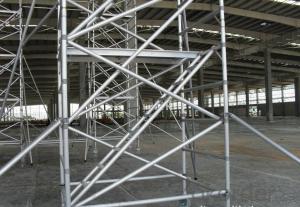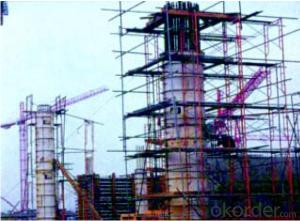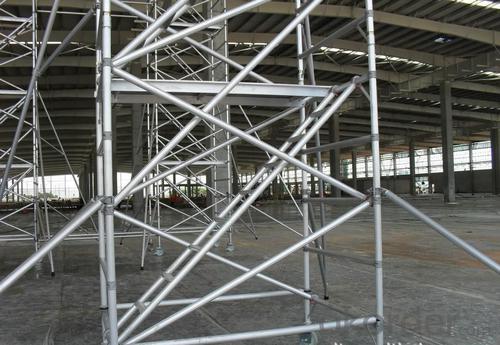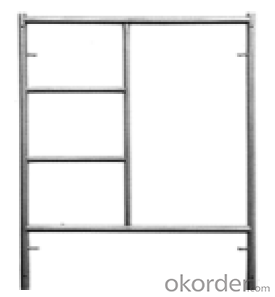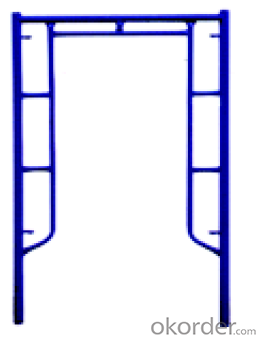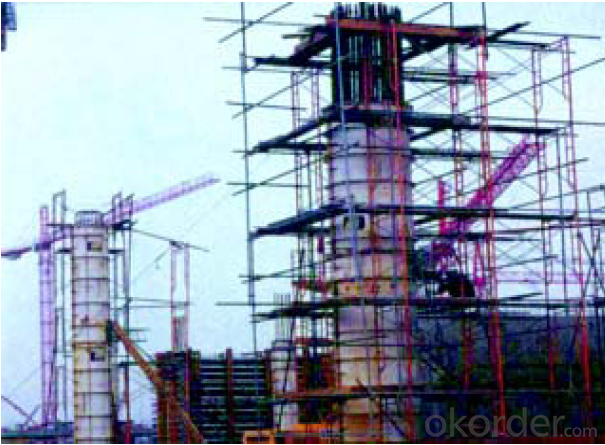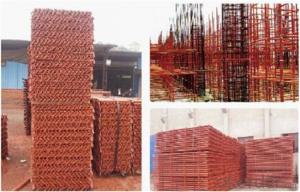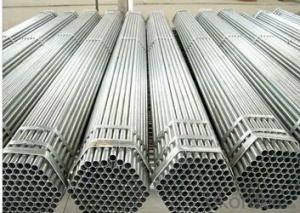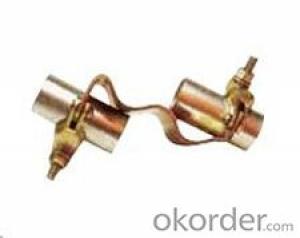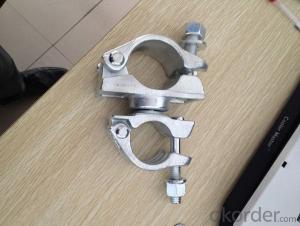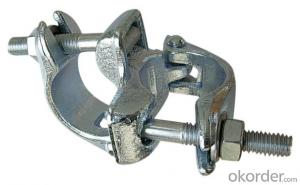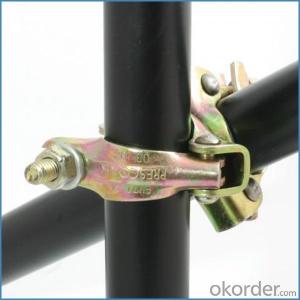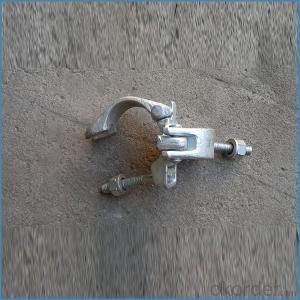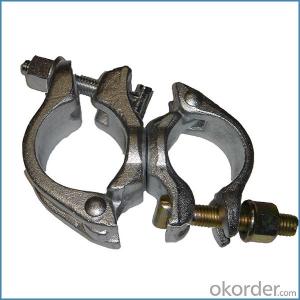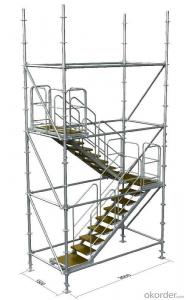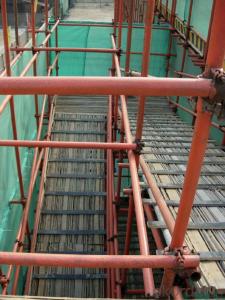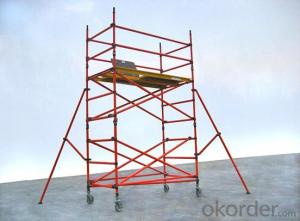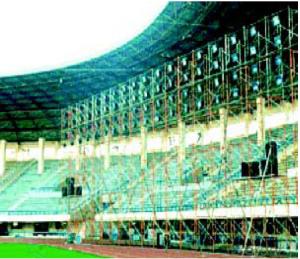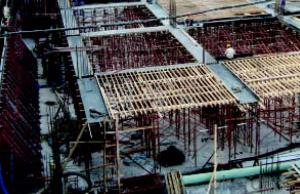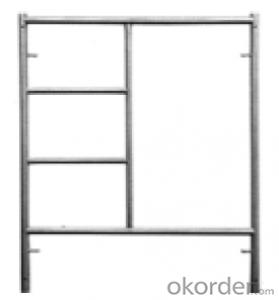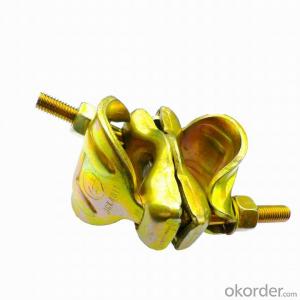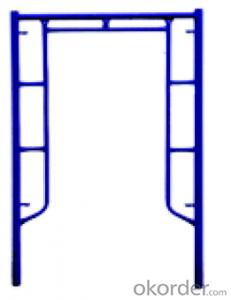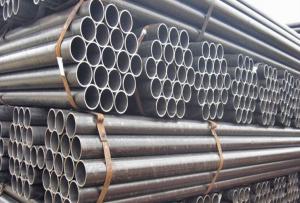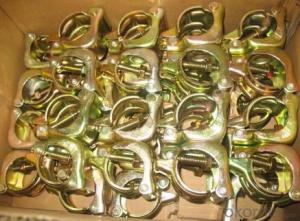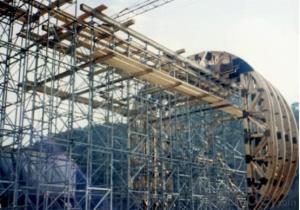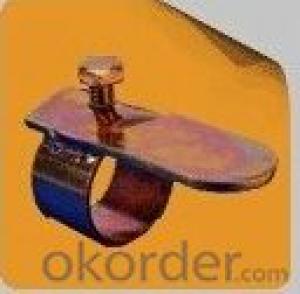Frame Connected Scaffolding with Simple and Flexible Structure
- Loading Port:
- Shanghai
- Payment Terms:
- TT OR LC
- Min Order Qty:
- 1 m²
- Supply Capability:
- 100000000 m²/month
OKorder Service Pledge
OKorder Financial Service
You Might Also Like
1. Structure of Frame-Connected Scaffolding
Presented like a shape of door , Frame-connected Scaffolding includes main frame, horizontal frame, cross brace, stage board and adjustable base. In order to display frame with couple system enough, good performance of stability ,firm structure of the whole, easy and fast to assemble and dismantle without any tools, safe working at height especially, and it is ideal material for construction engineering.
It can be widely used for industrial and civil construction and maintenance, such as workshop, large gymnasium, conference& exhibition center conversation, billboard, market, dock, tunnel, subways, etc. used for mobile working platform installation of electrical & mechanical engineering, ship repair and other decoration engineering, for building temporary stand ,with simple roof frame, frame-connected Scaffolding can from temporary dormitory, depot and work shed.
2. Main Features of Frame-Connected Scaffolding
.Reasonable structure, simple assembly, quick operation, safety& reliability.
.Easy to transport and knock down, high efficiently, save massive manpower and resource
.Easy to carry and operate with the weight about 20kg/p
.Assembly& disassembly with hands only to improve the efficiency highly, frame-connected scaffolding of assembly &disassembly saves half of the time than fasten steel-pipe scaffolding, and two third of the time than bamboo scaffolding.
.Widely usage, reasonable and practical, low aggregate cost.
3. Images
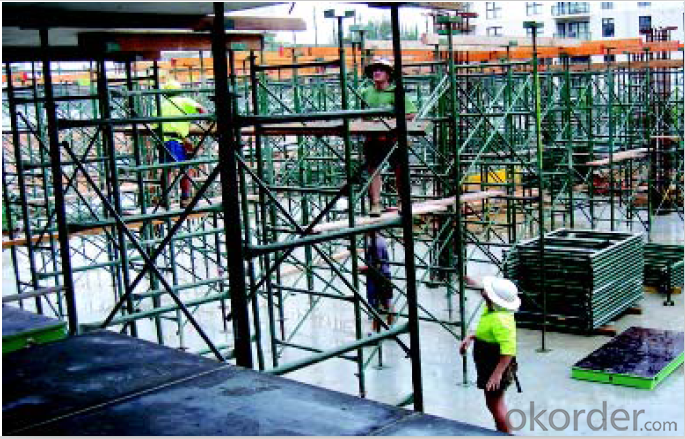
4. Specification
Maximum breaking load: 22.2t
Safe working loads on jack components(safety factor:3.5)
5. FAQ of Frame-Connected Scaffolding
1) What can we do for you?
We can ensure the quality of the vinyl banner and avoid extra expenses for customers.
.We can provide you the professional design team.
.We can provide fashionable and newest styles for you.
.We can design the artwork for you.
. Please feel free to customize.
2) What promises can be done by us?
. If interested in Frame-Connected Scaffolding, please feel free to write us for any QUOTE.
. If printing required, please advise asap because the whole set need much more time to complete.
. Please DO check goods when courier knocks your door and contact us asap if any issue.
3) What about of our after-sale service?
. Response will be carried out in 24hours after receiving any complain or request.
. Frame-Connected Scaffolding cost can be refund after order is confirmed.
. If the products are not based on the requirements, there will be the relevant compensations made for you.
4) What about the package and shipping time?
.Packing: As Customer's Requirements
.Shipping: We have various shipping ways for our customers, such as express which including TNT, DHL, FEDEX, UPS, EMS, etc. ; by air/ sea, and we are VIP of these express.
.Shipping time:
Normally small orders, it just 10-15 business days to arrive your hand; When comes to the customs declaration, it may need 7 days.
Other mass qty of Frame-Connected Scaffolding, we send them out by sea or by air to sea port or air port to save some shipping freight for our customers. By ocean, it may need 45~60days, by air, it may need 25~40days.
- Q: How do steel tube couplers contribute to the overall versatility of a scaffolding structure?
- Steel tube couplers play a crucial role in enhancing the overall versatility of a scaffolding structure. These couplers are used to connect different steel tubes together, creating a strong and stable framework that can withstand heavy loads and provide a safe working environment. One of the primary ways in which steel tube couplers contribute to versatility is through their ability to create various configurations and shapes. Couplers allow scaffolding tubes to be connected at different angles, enabling the construction of scaffolding structures in complex and challenging environments. This adaptability allows workers to reach different heights, work around obstacles, and access hard-to-reach areas, making scaffolding structures incredibly versatile. Furthermore, steel tube couplers are easily adjustable and reusable. Unlike traditional fixed scaffolding systems, couplers can be easily detached and repositioned, allowing for quick and efficient adjustments on the job site. This flexibility is particularly valuable in situations where the scaffolding structure needs to be modified or extended during the construction process. Additionally, steel tube couplers provide a high degree of stability and strength, ensuring the safety of workers and the integrity of the scaffolding structure. The tight connection created by these couplers eliminates any wobbling or movement in the scaffolding, making it a reliable platform for workers to carry out their tasks. This stability is especially important when working at great heights or in challenging weather conditions. Moreover, steel tube couplers are compatible with a wide range of scaffolding accessories and components. This compatibility allows for the integration of additional features such as guardrails, walkways, and stairs, further enhancing the versatility and functionality of the scaffolding structure. These accessories can be easily attached or detached using the couplers, providing flexibility to adapt the scaffolding system to specific project requirements. In conclusion, steel tube couplers contribute significantly to the overall versatility of a scaffolding structure. Their ability to create various configurations, easy adjustability, stability, and compatibility with other scaffolding components make them an essential element in constructing safe, efficient, and adaptable scaffolding systems.
- Q: Can steel tube couplers be used in both vertical and horizontal scaffolding applications?
- Yes, steel tube couplers can be used in both vertical and horizontal scaffolding applications. Steel tube couplers are versatile and can be used to connect steel tubes in various orientations and configurations. Whether it is for creating uprights and ledgers in vertical scaffolding or connecting transoms and braces in horizontal scaffolding, steel tube couplers provide a secure and reliable connection. Their durability and strength make them suitable for withstanding the loads and demands of both vertical and horizontal scaffolding applications.
- Q: What are the different locking mechanisms available for steel tube couplers?
- There are several different locking mechanisms available for steel tube couplers, each with its own advantages and applications. Some of the most common locking mechanisms include: 1. Wedge Locking System: This mechanism utilizes a wedge-shaped insert that is placed between the tubes and tightened using a bolt or nut. The wedging action creates a tight and secure connection, preventing any movement or rotation of the tubes. 2. Clamp Locking System: This mechanism involves the use of clamps that are tightened around the tubes to create a tight fit. These clamps can be adjusted and secured using bolts or nuts, ensuring a strong and reliable connection. 3. Screw Locking System: This mechanism uses screws that are threaded through the coupler and tightened to secure the tubes in place. The screws provide a firm grip on the tubes, preventing any slippage or movement. 4. Pin Locking System: This mechanism involves the use of pins or bolts that are inserted through holes in the coupler and tubes to hold them together. The pins are secured using nuts or clips, providing a secure and rigid connection. 5. Snap Locking System: This mechanism utilizes a snap or latch mechanism that locks the tubes together with a simple snap or push action. This type of locking mechanism is quick and easy to use, making it ideal for applications where frequent assembly and disassembly is required. 6. Compression Locking System: This mechanism involves compressing the tubes together using a compression sleeve or ring. The compression creates a tight and secure connection, preventing any movement or rotation of the tubes. Each of these locking mechanisms has its own advantages and suitability for different applications. Factors such as ease of assembly, strength, and reliability should be considered when selecting the appropriate locking mechanism for steel tube couplers.
- Q: Are steel tube couplers suitable for scaffolding projects in corrosive environments?
- No, steel tube couplers are not suitable for scaffolding projects in corrosive environments.
- Q: What are the potential risks or hazards associated with using steel tube couplers in scaffolding?
- Using steel tube couplers in scaffolding can be associated with several potential risks or hazards. One primary risk is the possibility of structural failure. If the couplers are not installed properly or if they exceed their recommended weight capacity, they may fail, leading to the collapse of the scaffolding structure. Such an event can cause severe injuries or even fatalities for workers or those nearby. Another risk is the potential for coupler slippage. If the couplers are not securely tightened, there is a chance that they may slip or become loose, resulting in instability in the scaffolding. This can cause workers to lose their balance and fall from heights, resulting in severe injuries. Improper use of steel tube couplers can also be hazardous for workers. If the couplers are not used in accordance with the manufacturer's instructions or industry standards, it can compromise the stability and integrity of the scaffolding system. This can create an unsafe working environment and increase the likelihood of accidents or injuries. Moreover, there is a risk of electrocution if steel tube couplers come into contact with live electrical wires or power sources. This can occur if the scaffolding is not adequately insulated or if workers accidentally make contact with electrical hazards while assembling or disassembling the scaffolding structure. Furthermore, the weight and bulkiness of steel tube couplers can make them difficult to handle and maneuver, especially when working at heights. If not handled properly, they can cause strain or injury to workers, leading to musculoskeletal disorders or accidents. To mitigate these risks, it is vital to ensure correct installation of all steel tube couplers, regular inspection for any signs of wear or damage, and adherence to specified weight capacities. Workers should receive training on the proper assembly and disassembly of scaffolding structures, as well as the safe handling of steel tube couplers. Regular safety inspections and maintenance should be conducted to ensure the integrity of the scaffolding system and minimize the risk of accidents or hazards.
- Q: Are there any specific guidelines for using steel tube couplers in scaffolding systems with limited ground support?
- Steel tube couplers in scaffolding systems with limited ground support require adherence to specific guidelines to ensure safety and stability. 1. Load capacity: Determining the load capacity of steel tube couplers is crucial for scaffolding systems with limited ground support. This involves considering the combined weight of workers, tools, and materials placed on the scaffolding. 2. Structural analysis: Conducting a structural analysis of the scaffolding system is advisable to assess stability and determine the appropriate size and number of steel tube couplers needed. This analysis should consider the height, span, and weight distribution of the scaffolding. 3. Coupler selection: Selecting steel tube couplers specifically designed for limited ground support is vital. These couplers should have a high load capacity and withstand project site conditions. 4. Coupler installation: Properly installing steel tube couplers is crucial for stability and safety. Couplers should be securely tightened and aligned to ensure a strong connection between tubes. 5. Bracing and support: Scaffolding systems with limited ground support may require additional bracing and support to enhance stability. This can include diagonal braces, tiebacks, and counterweights to prevent tipping or collapse. 6. Regular inspection and maintenance: Regularly inspecting and maintaining the scaffolding system, including steel tube couplers, is essential to identify any potential issues or defects. Replace any damaged or worn-out couplers immediately to maintain system integrity. 7. Compliance with regulations: Ensuring compliance with local regulations, industry standards, and best practices is crucial when using steel tube couplers in scaffolding systems with limited ground support. This includes obtaining necessary permits and following guidelines provided by regulatory authorities. By following these guidelines, the safe and effective use of steel tube couplers in scaffolding systems with limited ground support is ensured. It is recommended to consult with a qualified engineer or scaffolding expert to ensure safety standards are met and address specific project requirements.
- Q: Are steel tube couplers adjustable for different angles or slopes in scaffolding projects?
- Steel tube couplers can be adjusted to accommodate different angles or slopes in scaffolding projects. These couplers are specifically designed to establish a secure connection between scaffold tubes, enabling the creation of various configurations and adaptation to different angles or slopes. Their adjustable feature guarantees that scaffolding structures can be set up on uneven terrain or tailored to meet specific project needs. Through the use of these versatile couplers, workers can safely assemble scaffolding on slopes, inclines, or at various angles, ultimately providing a stable and secure platform.
- Q: What are the different types of steel tube couplers available?
- There is a variety of steel tube couplers to choose from, each with its own distinctive design and purpose. 1. Sleeve Couplers: The most commonly used steel tube couplers are sleeve couplers. They consist of a cylindrical sleeve with internal threads on both ends. By screwing the sleeve onto the threaded ends of the tubes, these couplers effectively join two steel tubes together. 2. Swivel Couplers: For connecting steel tubes at any angle, swivel couplers are the ideal choice. They have a swivel mechanism that allows for different orientations of the tubes. Swivel couplers find extensive use in scaffolding applications where flexibility in positioning is crucial. 3. Right-Angle Couplers: Designed specifically for connecting steel tubes at a 90-degree angle, right-angle couplers provide stability and rigidity in construction projects. With a fixed angle, they ensure a secure connection. 4. Putlog Couplers: When it comes to connecting steel tubes to walls or other structural elements, putlog couplers are the go-to option. They feature a flat plate with holes that are used to fasten the tube to the surface. In scaffolding systems, putlog couplers offer support and stability. 5. Half Couplers: To attach a steel tube to a flat surface, such as a wall or a beam, half couplers are the ideal solution. They have a flat plate with an opening that allows for the insertion of the tube, which can then be secured using bolts or screws. Half couplers find common use in construction projects that require the attachment of a tube to a fixed structure. 6. Beam Clamps: Beam clamps serve as specialized couplers for connecting steel tubes to beams or overhead structures. They feature a clamp mechanism that securely attaches them to the beam, providing a stable connection point for the tube. These examples highlight the diverse options available for steel tube couplers. The selection of the appropriate coupler depends on the specific application and project requirements. Ensuring a safe and secure connection between steel tubes necessitates the careful choice of the right coupler.
- Q: What are the common methods for connecting steel tube couplers in scaffolding systems?
- In scaffolding systems, there are various methods available for connecting steel tube couplers. One widely used approach is the double coupler connection, which requires placing two couplers on opposite sides of the tube and tightening the bolts to secure them. This method ensures a strong and reliable connection, making it suitable for heavy-duty scaffolding tasks. Another commonly employed technique is the swivel coupler connection. This type of coupler allows for a full 360-degree rotation, which proves beneficial when constructing scaffolding structures that require flexibility and adjustment. By attaching the swivel coupler to the tube, it becomes possible to connect another tube at any desired angle. A third method involves the use of putlog coupler connections. This coupler is specifically designed for connecting transoms or putlogs to the scaffolding tube. Typically, a single coupler is attached to the tube, providing a secure connection for horizontal members. Furthermore, sleeve coupler connections are frequently utilized in scaffolding systems. This method entails sliding a sleeve over the ends of two tubes and securing it with bolts, resulting in a robust and stable connection. Lastly, internal spigot couplers are employed to connect two tubes internally. This method involves inserting one end of a tube into the other and securing it with a pin or bolt. This type of connection is often preferred in scenarios where external couplers would be obstructive or impractical. In conclusion, these are several common methods for connecting steel tube couplers in scaffolding systems. The choice of method depends on the specific requirements of the scaffolding structure and the necessary load-bearing capacity.
- Q: Are steel tube couplers suitable for scaffolding in high wind conditions?
- Steel tube couplers are generally considered suitable for scaffolding in high wind conditions. Steel is a strong and durable material that can withstand the forces exerted by high winds. Couplers, which are used to connect steel tubes in scaffolding systems, are typically designed to provide a secure and stable connection. However, it is important to note that the suitability of steel tube couplers for high wind conditions also depends on other factors such as the design and construction of the scaffolding system, the overall stability of the structure, and adherence to proper safety standards and guidelines. In areas with consistently high wind conditions, it may be necessary to take additional precautions to enhance the stability of the scaffolding. This can include using additional bracing, tying down the scaffold to the building or other stable structures, or using wind load calculations to determine the appropriate size and spacing of the steel tubes and couplers. Ultimately, the suitability of steel tube couplers for scaffolding in high wind conditions is a complex issue that should be assessed on a case-by-case basis, considering all relevant factors and involving qualified professionals to ensure the safety and stability of the scaffolding system.
Send your message to us
Frame Connected Scaffolding with Simple and Flexible Structure
- Loading Port:
- Shanghai
- Payment Terms:
- TT OR LC
- Min Order Qty:
- 1 m²
- Supply Capability:
- 100000000 m²/month
OKorder Service Pledge
OKorder Financial Service
Similar products
Hot products
Hot Searches
